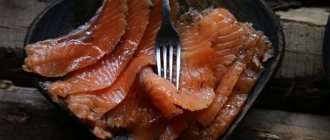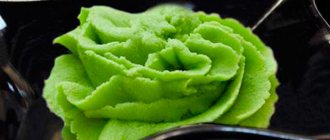Gabajou meat is an original Chinese dish that can most often be found in restaurants. However, many housewives like to cook gabajou at home. The recipe is simple, but the dish is nutritious and very tasty.
Even children rarely refuse to try it. This dish must be served with sweet and sour or salty sauce. It all depends on the preferences and capabilities of the cook.
Useful tips
- Use water at room temperature.
- Cut the meat across the grain, and when mixing, make sure that the pieces are intact; they tear easily.
- To add piquancy to the dish, it is better to use rice wine.
- Heat the frying oil well. To check, lower a block of chopped carrots. The oil will begin to bubble around the vegetable.
- Be careful when placing tenderloin in deep fryer. The oil “shoots” a lot. It's good to use a deep fryer.
- It is important not to overcook. When a golden crust appears, remove.
- Do not place the entire workpiece in the frying pan at once; the pieces should not come into contact with each other when frying.
- Read a separate article about the benefits and harms of pork.
Sweet and sour sauce
Making the sauce is very simple:
- First you need to finely chop one onion, 2 cloves of garlic, and ginger, then put them in a hot frying pan for frying.
- While the vegetables are sautéing, you need to boil 100 ml of vinegar and 150 grams of sugar in a small container, and then pour in 150 grams of ketchup and 30 ml of soy sauce.
- Vegetables are added to the pan, and only then 30 grams of flour and 15 grams of starch are poured. The mixture will need to be cooked until thick.
- At the end, the sauce is filtered and left to cool.
It is recommended to dilute the starch in a small amount of ice water before use and only then pour it into a common container. Making sweet and sour gabajou, the recipe for which is presented above, is very simple, but you can use other technologies, which will be described below.
Gabajou, like in a restaurant
To prepare a dish that tastes like a restaurant dish, you will need to follow the following cooking method:
- A kilogram of meat is cut into strips, always thin, and for slicing it is better to take a little frozen meat to make it easier to cut.
- Beat 2 eggs until smooth and add 100 ml of sparkling water and flour. Mineral water is necessary for the splendor of the batter. Flour is applied by eye so that the mixture has a consistency similar to sour cream.
- Now the meat pieces are dipped into the batter and thoroughly dipped in it.
- Next, heat up a frying pan with oil, which needs to be poured so that the pieces of pork begin to float. Pork is placed in hot oil and fried, the main thing is that it does not stick to the bottom.
- After frying, the pieces are placed on a napkin or towel to drain excess fat from the product. Then you will need to transfer it to a saucepan or large bowl.
- 350 grams of ketchup is poured into a saucepan and put on low heat, the main thing is that it does not boil. 50 grams of sugar, a teaspoon of vinegar and a tablespoon of soy sauce are also added to the saucepan. After thoroughly stirring everything, you need to warm it up for a short time, about 2 minutes.
- It is recommended to taste the sauce and, if necessary, add ingredients that are missing.
- At the end, the pork is poured with sauce and mixed thoroughly so that the meat is completely covered with it.
This cooking method is often used in various cafes and restaurants, but it can be prepared at home without difficulty.
Homemade chicken gabajou
The secret of cooking pork in sweet and sour sauce "Gobajou" or "Gu La Jou"
Ingredients:
- Pork pulp - 500g.
- Starch - 200 gr.
- Carrots - 1 pc. (optional)
- Sesame oil - 0.5 teaspoon (optional)
- Sugar - 5 tbsp. spoons
- Tomato paste - 1 tbsp. spoon
- Vinegar essence (70%) – 1 teaspoon
- Salt - 1 teaspoon without a slide
- Vegetable oil - for frying (about 0.5 liters)
Preparation:
- We free the pork from films and veins, trim off excess fat, and chop the meat into small pieces no more than 1 centimeter thick.
- Place the sliced pork into a deep bowl and add 200 grams to it. starch.
- Pour a little cold water into the meat with starch in a thin stream, about 150-200 g. (the main thing is not to overdo it!) so that after mixing the water with starch, a sticky sauce appears. Not very runny, but not thick either.
- We leave the meat and starch aside and go to work on the carrots, which can be excluded from this dish if desired. Cut the carrots into thin (no more than 2mm) slices, then turn them into thin strips.
- Pour a lot of vegetable oil into a wok or deep frying pan to hide the bottom by at least 4-5 centimeters.
- As soon as the oil is very hot, alternately, in several batches in one layer, and very carefully drop into the heated oil some pieces of pork, first, repeatedly and thoroughly mixed with starch (starch tends to harden and settle to the bottom at rest and therefore it is necessary stir each time before putting the meat in the oil).
- Some pieces of meat in starch batter are fried in oil for about 5 minutes, after which the finished pieces of pork are transferred with a slotted spoon into a separate container, and the next batch of pork is fried until the last batch of meat is cooked. After frying the pork, you can start preparing the sweet and sour sauce.
- Dissolve two teaspoons of starch in 3-5 teaspoons of cold water and put aside for a while. Diluted starch is needed to thicken the sweet and sour sauce, and is added at the very end of its preparation.
- In a cooled frying pan, where we plan to prepare the sweet and sour sauce , add 5 tablespoons of sugar and one tablespoon of tomato paste, place the pan on high heat.
- Pour one teaspoon of salt, pour 150 milliliters of boiling water into our future sweet and sour sauce, dilute the salt, sugar and tomato paste, stirring the sauce periodically, and as soon as it starts to boil, pour 1 teaspoon of 70 percent vinegar essence into it, just before Before pouring vinegar, do not lean over the frying pan, take care of your eyes and hold your breath! At first there will be a very strong acidic smell in the kitchen, but then everything will be fine.
- About 2 minutes after boiling our sweet and sour sauce , once again mix the starch with the water that we diluted earlier (since the starch had settled to the bottom again by this point), and pour it into our sweet and sour sauce, mix everything vigorously for 3 minutes, after which, pour about 2 tablespoons of vegetable oil into the sauce, and, if available, half a teaspoon of sesame oil (it gives the sauce, and the sweet and sour pork , a very specific aroma), mix everything thoroughly once again, and immediately pour pieces of fried pork into our sweet and sour sauce, which immediately need to be mixed vigorously so that the sauce is distributed throughout the pork.
Chinese Pork (Guo Bao Zhou)
The strange-sounding word “gabajou” refers to a Chinese dish - pork in starch. I don’t know how it is in China itself, but in Asian restaurant cuisine adapted to European tastes, this is perhaps one of the most popular recipes. On the one hand, it is immediately clear that he is “not ours”, exotic; and on the other hand, in terms of the level of seasoning, gabajou is usually not made in such a way that it immediately “fires from the ears and twists the lips.”
The overall flavor composition is sour-sweet-spicy. In terms of complexity, the recipe is one of those that needs to get used to, because some procedures are somewhat unusual for a European. But when you understand what’s what and why, you realize that the dish is essentially quite simple.
Ingredients:
- Pork - 1 kilogram;
- Bell pepper - 5 pieces;
- Ginger - 30 grams;
- Soy sauce - 50 Milliliters;
- Eggs - 2 pieces;
- Starch - 3 tbsp. spoons;
- Apple cider vinegar - 3 tbsp. spoons;
- Ketchup - 2 tbsp. spoons;
- Sugar - 3 tbsp. spoons.
How to cook:
1. Cut the pork into small pieces. If you wish, you can beat it off. Separate the yolks from the whites, add the first to the meat. Add 2 tbsp. starch and salt to taste. Add soy sauce. Cover with a lid or cling film and leave to marinate for about 20 minutes. 2. Pour approximately 300 ml of vegetable oil into a wok or other deep frying pan. When the meat is marinated, roll it in starch (immediately after marinating) and fry in boiling oil until golden brown. 3. Place the meat in a colander to drain excess oil. 4. In a small amount of vegetable oil, fry finely chopped ginger (for a minute) until it gives off a smell. Next, add the diced bell pepper and fry until tender (this will take about 5 minutes). 5. Add diced pineapple to the vegetables and prepare the sauce. To do this, dilute starch with 1 tbsp. Add this mixture to the apple cider vinegar. Add ketchup, stir until smooth. 6. Add sugar and sauce to the vegetables, mix evenly. Add previously fried meat. Mix everything and fry for a few minutes. When serving, sprinkle with sesame seeds. Bon appetit!
Chinese cuisine - diversify your menu
Cheese soup Sa Cha with seafood and mushrooms
Traditional soup from Southern China has a unique aroma and rich taste. The dish is worthy of being prepared for lunch.
Broccoli with champignons and cheese
A great option for an easy, healthy, simple and quick dinner to prepare. The low-calorie dish is rich in protein, fiber and promotes good digestion.
Apples in caramel with ginger and raisins
Caramel apples are a popular delicacy sold in many restaurants. Relates to Chinese and European cuisine. There are a lot of cooking options. Let's prepare the dish ourselves and delight our loved ones. Children will especially love it!
Baked chicken legs in mustard-honey marinade
What dish takes so little time? 5-7 minutes to prepare, and then just put it in the oven, chicken drumsticks in mustard-honey sauce.
Spaghetti with zucchini, carrots and minced meat
Great Chinese style spaghetti lunch option. During cooking, the vegetables in this dish are quickly fried over high heat, with constant stirring. With this method of cooking, they retain their structure and remain crispy. Chinese style spaghetti with vegetables
Chicken in honey sauce with sesame seeds
Chicken dishes are very versatile. You can add completely different ingredients to them. And if you won’t surprise anyone with standard flavor combinations, the Chinese version will surprise all your guests and family. The chicken is juicy and sweet, with a slight tangy sesame flavor. Chicken fillet for this recipe can be served with rice, dishes from.
Cooking gabajou meat: recipe with photos
First you need to mix starch, protein, flour and pour ice water into the mixture. You should get the same consistency as thick sour cream. Then cut the pork fillet into pieces approximately 2 x 2 cm. Beat them lightly (this will allow them to cook faster).
Place the pieces of meat in the batter, mix well to ensure even coating. The mass must be deep-fryed or in a roaster in vegetable oil (there should be a lot of it).
When a golden crust appears, frying is over. As a rule, no more than 10 minutes. Place the meat on a paper towel to drain excess fat. Place the prepared dish in a container and pour in the sauce. It can be salty or sweet and sour. The Chinese gabajou recipe is in demand. This dish is served in restaurants, but it can easily be made at home at a lower cost.
Gabajou recipe. Calorie, chemical composition and nutritional value.
Nutritional value and chemical composition of "Gabajou".
The table shows the nutritional content (calories, proteins, fats, carbohydrates, vitamins and minerals) per 100 grams of edible portion.
| Nutrient | Quantity | Norm** | % of the norm in 100 g | % of the norm in 100 kcal | 100% normal |
| Calorie content | 270.7 kcal | 1684 kcal | 16.1% | 5.9% | 622 g |
| Squirrels | 16.8 g | 76 g | 22.1% | 8.2% | 452 g |
| Fats | 13.6 g | 56 g | 24.3% | 9% | 412 g |
| Carbohydrates | 20.2 g | 219 g | 9.2% | 3.4% | 1084 g |
| Organic acids | 0.3 g | ~ | |||
| Alimentary fiber | 1.8 g | 20 g | 9% | 3.3% | 1111 g |
| Water | 35 g | 2273 g | 1.5% | 0.6% | 6494 g |
| Ash | 2.544 g | ~ | |||
| Vitamins | |||||
| Vitamin A, RE | 246.6 mcg | 900 mcg | 27.4% | 10.1% | 365 g |
| beta carotene | 1.482 mg | 5 mg | 29.6% | 10.9% | 337 g |
| beta Cryptoxanthin | 0.206 mcg | ~ | |||
| Lycopene | 0.026 mcg | ~ | |||
| Lutein + Zeaxanthin | 0.879 mcg | ~ | |||
| Vitamin B1, thiamine | 0.114 mg | 1.5 mg | 7.6% | 2.8% | 1316 g |
| Vitamin B2, riboflavin | 0.189 mg | 1.8 mg | 10.5% | 3.9% | 952 g |
| Vitamin B4, choline | 64.84 mg | 500 mg | 13% | 4.8% | 771 g |
| Vitamin B5, pantothenic | 0.535 mg | 5 mg | 10.7% | 4% | 935 g |
| Vitamin B6, pyridoxine | 0.406 mg | 2 mg | 20.3% | 7.5% | 493 g |
| Vitamin B9, folates | 11.266 mcg | 400 mcg | 2.8% | 1% | 3551 g |
| Vitamin B12, cobalamin | 0.011 mcg | 3 mcg | 0.4% | 0.1% | 27273 g |
| Vitamin C, ascorbic acid | 23.09 mg | 90 mg | 25.7% | 9.5% | 390 g |
| Vitamin E, alpha tocopherol, TE | 4.053 mg | 15 mg | 27% | 10% | 370 g |
| gamma tocopherol | 0.063 mg | ~ | |||
| Vitamin H, biotin | 1.296 mcg | 50 mcg | 2.6% | 1% | 3858 g |
| Vitamin K, phylloquinone | 2.4 mcg | 120 mcg | 2% | 0.7% | 5000 g |
| Dihydrophylloquinone | 0.034 mcg | ~ | |||
| Vitamin RR, NE | 5.5348 mg | 20 mg | 27.7% | 10.2% | 361 g |
| Niacin | 2.199 mg | ~ | |||
| Betaine | 0.087 mg | ~ | |||
| Macronutrients | |||||
| Potassium, K | 385.16 mg | 2500 mg | 15.4% | 5.7% | 649 g |
| Calcium, Ca | 41.59 mg | 1000 mg | 4.2% | 1.6% | 2404 g |
| Silicon, Si | 0.194 mg | 30 mg | 0.6% | 0.2% | 15464 g |
| Magnesium, Mg | 45.32 mg | 400 mg | 11.3% | 4.2% | 883 g |
| Sodium, Na | 591.41 mg | 1300 mg | 45.5% | 16.8% | 220 g |
| Sera, S | 198.29 mg | 1000 mg | 19.8% | 7.3% | 504 g |
| Phosphorus, P | 189.9 mg | 800 mg | 23.7% | 8.8% | 421 g |
| Chlorine, Cl | 496.36 mg | 2300 mg | 21.6% | 8% | 463 g |
| Microelements | |||||
| Aluminium, Al | 145.1 mcg | ~ | |||
| Bor, B | 37.9 mcg | ~ | |||
| Vanadium, V | 4.37 mcg | ~ | |||
| Iron, Fe | 2.038 mg | 18 mg | 11.3% | 4.2% | 883 g |
| Yod, I | 7.49 mcg | 150 mcg | 5% | 1.8% | 2003 |
| Cobalt, Co | 7.967 mcg | 10 mcg | 79.7% | 29.4% | 126 g |
| Lithium, Li | 0.686 mcg | ~ | |||
| Manganese, Mn | 0.8353 mg | 2 mg | 41.8% | 15.4% | 239 g |
| Copper, Cu | 162.09 mcg | 1000 mcg | 16.2% | 6% | 617 g |
| Molybdenum, Mo | 11.293 mcg | 70 mcg | 16.1% | 5.9% | 620 g |
| Nickel, Ni | 9.321 mcg | ~ | |||
| Tin, Sn | 21.68 mcg | ~ | |||
| Rubidium, Rb | 68 mcg | ~ | |||
| Selenium, Se | 2.388 mcg | 55 mcg | 4.3% | 1.6% | 2303 g |
| Titanium, Ti | 0.53 mcg | ~ | |||
| Fluorine, F | 79.84 mcg | 4000 mcg | 2% | 0.7% | 5010 g |
| Chromium, Cr | 11.32 mcg | 50 mcg | 22.6% | 8.3% | 442 g |
| Zinc, Zn | 1.9056 mg | 12 mg | 15.9% | 5.9% | 630 g |
| Digestible carbohydrates | |||||
| Starch and dextrins | 12.042 g | ~ | |||
| Mono- and disaccharides (sugars) | 7.6 g | max 100 g | |||
| Galactose | 0.003 g | ~ | |||
| Glucose (dextrose) | 0.832 g | ~ | |||
| Sucrose | 1.474 g | ~ | |||
| Fructose | 0.697 g | ~ | |||
| Essential amino acids | 0.123 g | ~ | |||
| Arginine* | 0.131 g | ~ | |||
| Valin | 0.129 g | ~ | |||
| Histidine* | 0.045 g | ~ | |||
| Isoleucine | 0.112 g | ~ | |||
| Leucine | 0.16 g | ~ | |||
| Lysine | 0.126 g | ~ | |||
| Methionine | 0.065 g | ~ | |||
| Methionine + Cysteine | 0.107 g | ~ | |||
| Threonine | 0.09 g | ~ | |||
| Tryptophan | 0.032 g | ~ | |||
| Phenylalanine | 0.118 g | ~ | |||
| Phenylalanine+Tyrosine | 0.18 g | ~ | |||
| Nonessential amino acids | 0.163 g | ~ | |||
| Alanin | 0.119 g | ~ | |||
| Aspartic acid | 0.201 g | ~ | |||
| Glycine | 0.074 g | ~ | |||
| Glutamic acid | 0.291 g | ~ | |||
| Proline | 0.071 g | ~ | |||
| Serin | 0.122 g | ~ | |||
| Tyrosine | 0.073 g | ~ | |||
| Cysteine | 0.046 g | ~ | |||
| Sterols (sterols) | |||||
| Phytosterols | 1.58 mg | ~ | |||
| beta sitosterol | 17.143 mg | ~ | |||
| Saturated fatty acids | |||||
| Saturated fatty acids | 1 g | max 18.7 g | |||
| 10:0 Kaprinovaya | 0.022 g | ~ | |||
| 12:0 Lauric | 0.001 g | ~ | |||
| 14:0 Miristinovaya | 0.001 g | ~ | |||
| 16:0 Palmitinaya | 0.544 g | ~ | |||
| 18:0 Stearic | 0.355 g | ~ | |||
| 20:0 Arakhinovaya | 0.026 g | ~ | |||
| 22:0 Begenovaya | 0.06 g | ~ | |||
| Monounsaturated fatty acids | 2.053 g | min 16.8 g | 12.2% | 4.5% | |
| 16:1 Palmitoleic | 0.001 g | ~ | |||
| 18:1 Oleic (omega-9) | 2.043 g | ~ | |||
| 18:1 cis | 0.005 g | ~ | |||
| 22:1 Erucic (omega-9) | 0.001 g | ~ | |||
| Polyunsaturated fatty acids | 5.15 g | from 11.2 to 20.6 g | 46% | 17% | |
| 18:2 Linolevaya | 5.143 g | ~ | |||
| 18:3 Linolenic | 0.006 g | ~ | |||
| 18:3 Omega-3, alpha-linolenic | 0.003 g | ~ |
The energy value of Gabajou is 270.7 kcal.
Primary Source: Created in the application by the user. Read more.
** This table shows the average levels of vitamins and minerals for an adult. If you want to know the norms taking into account your gender, age and other factors, then use the “My Healthy Diet” application.
Advice from experienced chefs
Each housewife prepares the same dish differently. However, many chefs are ready to share their secrets of cooking gabajou meat. Of course, you need to know the recipe, but you still can’t do without some secrets:
- You need to add not just cold water to the batter, but ice water. Then you get a crispy crust that leaves behind a pleasant aftertaste.
- It is advisable to cut the meat into cubes. The taste of the dish itself depends on the cut.
- The gabajou meat will taste much better if it is served with the sauce rather than on its own.
- Try to fry the dish for a short time so that it does not dry out. If you don’t want to get the taste of spicy meat, then you must add spices. At least black or red ground pepper.
- Do not put all the meat in the pan, as it will stick to each other and ruin not only the aesthetic appearance, but also the taste of the dish.
- For a more beautiful looking sauce, add 2-3 tablespoons of tomato paste and a little sugar to set the color.
- The sauce must be constantly stirred so as not to burn.
- To make the dish look more aesthetically pleasing, you can layer the meat and sauce.
- You can serve gabajou with almost any side dish, but many people like it with both rice and mashed potatoes.
Try, experiment - and you will pleasantly surprise your guests and your household with new, original and very tasty gabajo meat. The recipe is simple, so every housewife can prepare such a dish.
Homemade gabajou
To make gabajou recipe at home, you will need to use more ingredients, but the dish turns out very tasty. To prepare you need:
- Pork – 700 g.
- Carrots, onions, peppers - 1 pc.
- Garlic – 4 cloves.
- Canned pineapple – 200 g.
- Ginger – 20 g.
- Starch - 4 tbsp. l.
- Flour – 3 tbsp. l.
- Egg white – 1 pc.
- Cold water – 125 g.
- Soy sauce – 3 tbsp. l.
- Honey - 1.5 tbsp. l.
- Tomato paste – 2 tbsp. l. or juice - 200 ml.
- Rice vinegar – 1 tbsp. l.
Cooking technology:
- The washed meat is cut into strips and then beaten with a hammer on both sides.
- Next, a starch batter is prepared, protein and a spoonful of soy sauce are added to it, as well as cold water, everything is thoroughly mixed and whipped.
- To thicken the batter, flour is used, which needs to be poured in and mixed until it reaches the consistency of sour cream.
- The meat is placed in batter and rolled, and then sent to a hot frying pan with oil for frying on all sides.
- While the meat is frying, you need to cut the ginger and vegetables, preferably into strips.
- Remove the fried meat and leave it in a bowl, and put the onions and carrots in the frying pan for sautéing.
- After 5 minutes, add pepper, garlic and ginger root. All products are left to stew.
- While the vegetables are sautéing, you need to mix soy sauce and honey, and then add vinegar and tomato paste or tomato juice.
- More pineapple is added to the pan, and after that the finished sauce is completely poured out. You need to simmer the ingredients for about 10 minutes until everything thickens.
The gabajou, the recipe for which is described, is ready, and to serve you need to put the meat on a large dish and pour over the hot sauce. Recommended to be served with rice and only hot.
What ingredients are needed?
The gabajou meat recipe is available to every housewife. You don’t need to spend a lot of money on it, but it turns out to be a very tasty and healthy dish.
First, prepare the ingredients needed for the dish:
- Lean pork fillet – 0.5 kg.
- The water is not cold, but ice-cold - ½ tbsp.
- Starch - 3 tbsp. l.
- Flour – 2 or 3 tbsp. l. (by thickness).
- Egg (white only) – 1 pc.
- Vegetable oil - about 1 liter.
- Salt - approximately 1 tsp. (most often to taste).
Adviсe
When preparing such a dish, you need to remember and take into account a couple of tips:
- The meat can be breaded directly in starch, or you can add all the starch to the marinade. There is no significant difference, the dish is prepared differently, but in the end the taste is the same.
- Gabajou can be supplemented with vegetables if desired, as in the homemade recipe, then the taste will be more piquant.
- Not only pork meat is used for cooking; it can be replaced with chicken or other poultry.
Salty sauce
To prepare it, take 200 grams of mushrooms. Champignons are perfect. Cut one medium-sized onion, carrot and bell pepper into strips. You will also need 1 tablespoon of starch, 3 tbsp. l. soy sauce, 4 cloves of garlic, thinly sliced, and ground red pepper or other spices to taste.
First, place the garlic in hot vegetable oil, then the chopped vegetables (onions, carrots and peppers). Fry the mushrooms in a separate pan. They need to be ready to add to the vegetables and then fry along with garlic, onions, carrots and peppers.
When the vegetables and mushrooms are fried, pour in the soy sauce. Pour starch into a small amount of water and mix. It needs to be poured into the frying pan where the vegetables and soy sauce are simmering. Bring the mixture to the thickness you need, season with spices. The sauce is ready to eat.
The correct recipe for making gabajou
Translated, “gabajou” means “pork in starch.” Perhaps these are the main components of the dish. To prepare gabajou, the recipe for which will be described in detail, you should:
- Rinse 0.5 kg of lean pork and cut into squares or strips, the thickness of which is about 5 mm.
- Beat the finished pieces on both sides, and then transfer to a plate and pour in 50 ml of soy sauce, add a couple of tablespoons of starch and about 150 ml of water. The ingredients are mixed until the marinade has a viscous consistency.
- The meat is left in the finished marinade for 20 minutes, during which time it is necessary to constantly stir the pork so that the starch does not remain at the bottom.
- Now pour about 500 ml of oil into the frying pan and put 150 grams of starch on a plate. The pork is removed from the marinade and rolled in starch, and then sent into hot oil. You need to fry on both sides for a couple of minutes.
- The finished meat is placed on a plate, but the recipe is not yet finished. The main secret of gabajou is the sauce recipe, which should be sweet and sour.
- To prepare the sauce, put 50 grams of sugar, 10 grams of salt and a teaspoon of vinegar essence in a clean and heated frying pan, stir everything quickly, and when the contents melt, add 20 grams of tomato paste and a couple of tablespoons of oil. Everything is mixed, and when the mass becomes covered with bubbles, in other words, boils, then 150 ml of water is poured in, in which 3 tsp is previously diluted. starch.
- As soon as the contents begin to boil, stirring, cook for another couple of minutes to get a beautiful color with red and orange tints.
- Next, transfer the meat into the sauce, directly into the frying pan, and stir for a couple more minutes so that the pork is completely drowned in it.
- All the sauce should stick to the pork, after which the fire is removed, and the finished dish is placed in the bowl where the meat was previously.
You will definitely love this recipe for gabajou in sweet and sour sauce. It is recommended to eat and serve it hot, but the cold dish is also very tasty.
List of ingredients
It is extremely important to adhere to the specified weight of the ingredient, because the cooking time in the multicooker depends on the amount of food. Therefore, if the weight changes, then the program timer will need to be changed. Before cooking you need to take:
- chicken fillet – 600 g (the weight of the main and all other products is calculated for three servings);
- vegetable oil – 2 tbsp. l.;
- apples – 1 pc. (it is best to purchase large firm apples, then at the end of cooking they will be completely soft, but still their shape will remain the same).
These ingredients make up the main part of the dish for preparing chicken fillet in sweet and sour sauce; you will also need to take two tablespoons of soy sauce and ketchup and one spoon each of mustard and honey.











